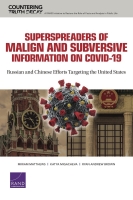by Miriam Matthews, Katya Migacheva, Ryan Andrew Brown
 What types of COVID-19-related malign and subversive information efforts did sources linked to Russia and to China use in targeting U.S. audiences from January 2020 to July 2020?
What types of COVID-19-related malign and subversive information efforts did sources linked to Russia and to China use in targeting U.S. audiences from January 2020 to July 2020?What are the similarities and differences in COVID-19-related malign and subversive information efforts from Russian- and Chinese-linked sources?
The global spread of coronavirus disease 2019 (COVID-19) created a fertile ground for attempts to influence and destabilize different populations and countries. Both Russia and China appear to have employed information manipulation during the COVID-19 pandemic in service to their respective global agendas. This report uses exploratory qualitative analysis to systematically describe the types of COVID-19-related malign and subversive information efforts with which Russia- and China-associated outlets appear to have targeted U.S. audiences from January 2020 to July 2020 and organizes them into a framework. This work lays the foundation for a better understanding of how and whether Russia and China might act and coordinate in the domain of malign and subversive information efforts in the future. This report is the first in a series that will use big data, computational linguistics, and machine learning to test findings and hypotheses generated by the initial analysis.
This report is part of RAND's Countering Truth Decay initiative, which considers the diminishing role of facts and analysis in political and civil discourse and the policymaking process. Disinformation and its rampant spread online and offline is one of the key drivers of Truth Decay. Agents—notably such foreign actors as Russia and China and their proxies—fuel and contribute to the explosion in disinformation observed over the past decade. Knowing how Russia and China operate in this space can help inform our understanding of the Truth Decay phenomenon and efforts to mitigate it.
Key Findings
Both countries disseminated messages through a wide variety of channels and platforms, including social media.
Both countries attempted to tarnish the reputation of the United States by emphasizing challenges with its pandemic response and characterizing U.S. systems as inadequate.
Both countries falsely accused the United States of developing and intentionally spreading the virus.
The two countries appeared to differ in their principal goals for COVID-19-related information efforts: Russia aimed to destabilize the United States; China aimed to protect and enhance its own international reputation.
Both countries modified their COVID-19-related messaging over time, focusing on conspiracy theories about the virus's origins and impacts from March 2020 to April 2020 and later moving to concentrate on perceived U.S. failure in responding to the pandemic.
While Russia deployed media with wide-ranging ideologies and a variety of audiences, China-linked messaging was ideologically uniform, consistent across multiple information outlets, and appeared to target audiences that were less varied.
Countering apparent Russian and Chinese malign and subversive information efforts will require campaigns that consider the capabilities and thematic emphasis of each of these actors.
Profiling Russian and Chinese sources known to frequently create and disseminate disinformation and propaganda can also inform counter-messaging efforts.
China and Russia appear to amplify one another's messages, when opportune. This might eventually lead to some collaboration, albeit limited in nature.
Public health messaging should account for potential impacts of Russian and Chinese messaging on vaccination uptake.
No comments:
Post a Comment